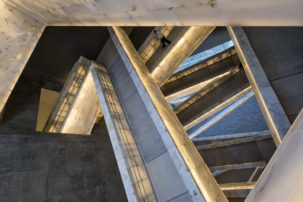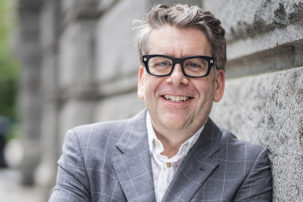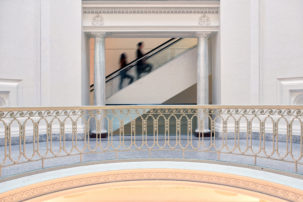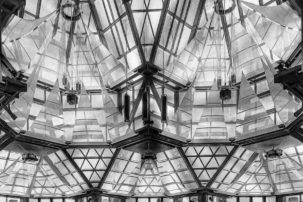A strike of roughly 200 Vancouver Art Gallery workers has ended.
The labour dispute between workers and the gallery was referred to mediation on Sunday. This mediation resulted in a new tentative offer on the part of the gallery.
Today, a vote was held on the new offer. The vote ended at 5 p.m. Pacific Time.
Earlier this evening, both management representatives and union officials confirmed that a majority of unionized workers had voted to ratify the new offer.
“We thereby issue a full return to work as of 8:00 a.m. on February 12, 2019,” says a post by the union bargaining committee posted on the CUPE 15 website this evening. It adds: “You’ve made us all very proud to represent you at the bargaining table and on the picket line. The new agreement is the foundation upon which we can grow a new positive era of labour relations at the Vancouver Art Gallery.”
“Both parties [CUPE and the Gallery] have been able to work closely together to come to an agreement that is fair and balanced,” said a statement from Johanie Marcoux, director of marketing, communications and public programs. “The new four-year agreement we have been able to reach allows us to move forward in a sustainable and responsible manner as a not-for-profit organization.”
The strike, which began on the morning of February 5, was marked by some of Vancouver’s coldest weather in some time.
The strike was also marked by a show of artist and arts community support for striking workers. Among those artists who visited the picket line in support were Venice Biennale alums Geoffrey Farmer and Rebecca Belmore, Governor General’s Award winner Takao Tanabe, Sobey Art Award winner Brian Jungen, and VIVA Award winners Lyse Lemieux and Hannah Jickling. Belmore also spoke at a public rally on Saturday in support of the workers.
Online, letters from other artists to the gallery were shared. In one of them, Rodney Graham tells gallery director Kathleen Bartels and board chair David Calabrigo he finds their earlier offer to workers “unseemly.” In another directed towards Bartels, Raymond Boisjoly states “The contrast between your salary and the wages they are requesting suggests there is much to be done in terms of acknowledging the crucial work gallery staff do to realize the gallery’s programming and general operations.” (Canadian Revenue Agency documents for the Vancouver Art Gallery suggest that Bartels’ salary is over $350,000, and that it has risen at least 17% between 2013 and 2017.)
CUPE 15 president Warren Williams tells Canadian Art that the offer developed with the mediator on Sunday included a total of 6.75% in cost-of-living wage increases over a four-year contract term.
Inadequate wage increases had been a sticking point for the gallery’s striking workers—particularly in light of a much-heralded $1 million+ gallery surplus in 2017-2018 and a record-breaking $40 million donation towards a new gallery building in recent weeks.
When Vancouver Art Gallery workers began their strike on February 5, the union bargaining committee stated that the increases offered by gallery management amounted to 4.75% over three years. Media reports in recent days indicated that the union, at the time of the strike, had been pushing for 5.5% in cost-of-living increases over three years.
During the strike, gallery representatives had stated they believed 4.75% to be “a fair and sustainable offer, and is consistent with the BC Bargaining database of ratified agreements thus far.”
Tonight, a Vancouver gallery representative relayed the following statement from gallery director Kathleen Bartels: “The Vancouver Art Gallery has an incredibly talented, dedicated and passionate staff and we are so pleased that an amicable resolution was reached with CUPE 15, and we look forward to welcoming everyone back to the Gallery… We believe this four-year contract will keep the Gallery on a path of collaboration, stability and future growth.”
The second major sticking point for strikers in the gallery’s earlier offer was the ending a nine-day fortnight for new hires. (The fortnight allows certain workers to complete two weeks of contracted hours over nine days rather than ten.) The union was concerned this new rule for new workers only would lead to a two-tier work environment.
In the new offer developed with a mediator and ratified today by the gallery workers, the nine-day fortnight remains—but it is subject to thrice-yearly blackout periods during which the nine-day fortnight does not apply, says Williams.
“It was needed to put up exhibitions” and deal with other intense work periods, says CUPE’s Warren Williams of the thrice-yearly shift to a five-day-per-week schedule.
The upcoming work at the gallery in the short term is bound to be intense, too, as the exhibition “French Moderns: Monet to Matisse” still appears to be scheduled to open on February 16.
In the long term, it’s quite possible tensions will persist on other fronts between workers and management—namely concerns that have surfaced about troubled working conditions and deficient HR practices at the gallery.
Among the other letters to the gallery posted online during the campaign is one by former Vancouver Art Gallery intern, and current Richmond Art Gallery director, Shaun Dacey. Dacey stated that “I have personally witnessed the VAG’s management style as an intern, a partnering organizational lead, and most importantly, as a friend/colleague to VAG staff. Upper management over the years has cultivated a disrespectful and toxic work culture that undermines and demeans staff on a regular basis.”
Dacey wrote further, “I want to support the VAG towards its future goals, but at this point I can’t get behind an institution that fails to confront its internal HR issues as enthusiastically as it pursues funding for a new building.”
Said the union bargaining committee in a statement to its members this evening: “We understand many of you had concerns with the expectations of the employer upon returning to work. Due to the labour dispute many timelines and schedules have changed. Tomorrow will not be ‘business as usual’; we will all need to sit down with our managers and develop a strategy for completing work over the following weeks.”
The union committee added: “There will certainly be an adjustment period for both parties.”
Small changes were made to copy in this article shortly after publication on February 11, 2019, to eliminate repetition of words and enhance clarity.

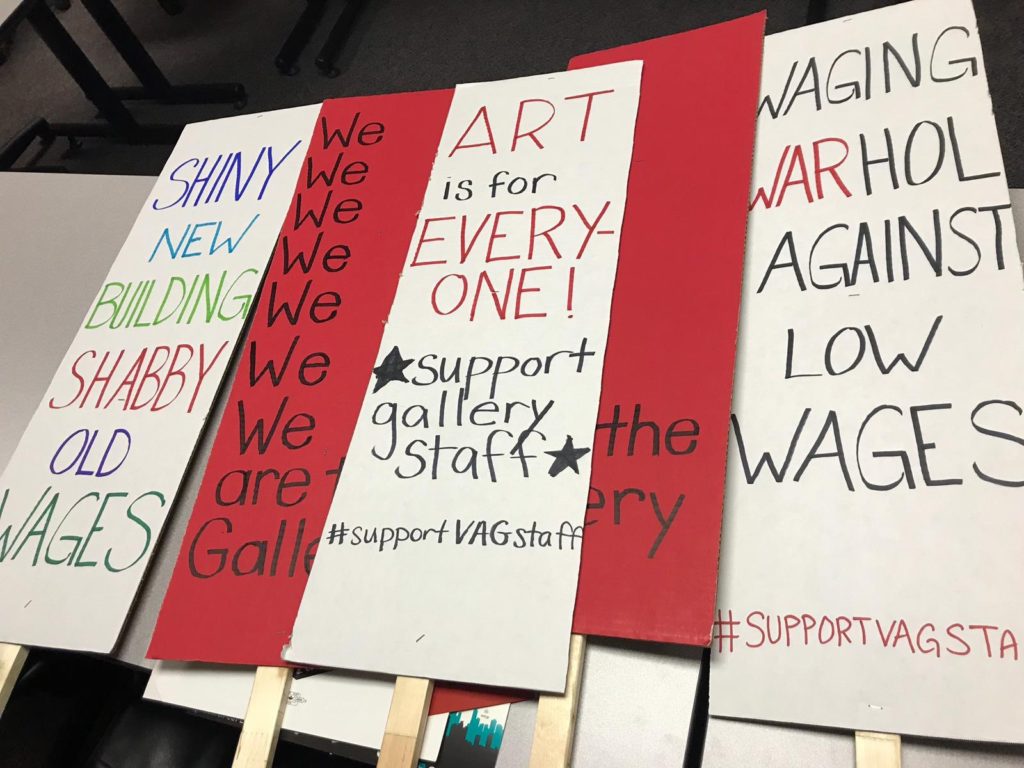 Signs from the strike at the Vancouver Art Gallery. Photo: Twitter / @vagonstrike.
Signs from the strike at the Vancouver Art Gallery. Photo: Twitter / @vagonstrike.

